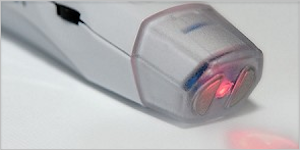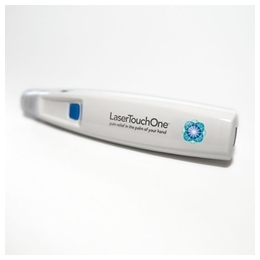Use of the Cold Laser on Pets
Share


We have become huge fans of the cold laser since purchasing our first one about eight years ago. We use it almost daily on ourselves (I am a longtime sufferer of TMJ and Carpal Tunnel) and we use it on our pets as needed.
Cheiss, our senior dog, is one of the more frequent recipients of treatment due to his ongoing problems with hip dysplasia. We also have a cat who regularly receives treatments as he suffers from a bit of arthritis. Two of our good friends use it on their horses for a variety of ailments.
Cold Laser Therapy (also known as Low Level Laser Therapy or LLLT) is a type of treatment that utilizes very specific light wavelengths to help accelerate the healing process in pets and people. There are a few things you need to know before you run out and buy one, though.
[note icon=”yes”]We are avid users of this product and have been since the company was first initiated. Not only are we avid users of the LLLT, but we are able to offer a limited number for sale at a significant discount. If you have interest in obtaining one at this discounted rate, please contact us using the form below. You can also order directly from the Laser Touch One site for $699.[/note][heading style=”2″ color=”#996633″ style_color=”#996633″]What Cold Lasers Treat[/heading]
Cold lasers are highly effective for treating acute or chronic pain, and are often used to help with a variety of other soft-tissue injuries. LLLT is used to reduce swelling, decrease muscle spasms, relieve arthritic pain and accelerate the healing of injuries in joints, tendons and soft-tissue injuries.
[heading style=”2″ color=”#996633″ style_color=”#996633″]How Cold Lasers Work[/heading]
 Lasers and LED’s produce intense beams of light at specific wavelengths. When the correct wavelength is used at the correct location, you can stimulate repair, resolve inflammation and reduce pain. Cold lasers use specific wavelengths of light to pass through layers of skin and penetrate 2-5 centimeters below the skin. The light energy passes through the skin to reach the target healing area, and interacts with the light sensitive elements of cells. It’s quite similar to the process of photosynthesis in plants. This helps to normalize cell damage or repair injured tissue by increasing intracellular metabolism.
Lasers and LED’s produce intense beams of light at specific wavelengths. When the correct wavelength is used at the correct location, you can stimulate repair, resolve inflammation and reduce pain. Cold lasers use specific wavelengths of light to pass through layers of skin and penetrate 2-5 centimeters below the skin. The light energy passes through the skin to reach the target healing area, and interacts with the light sensitive elements of cells. It’s quite similar to the process of photosynthesis in plants. This helps to normalize cell damage or repair injured tissue by increasing intracellular metabolism.
[heading style=”2″ color=”#996633″ style_color=”#996633″]How to Use Cold Lasers at Home[/heading]
If you decide to purchase a cold laser, the one we personally recommend is the Laser Touch One. We are quite familiar with this unit, having used it on ourselves and our pets for several years now. (In fact, we’re so enamored with the product that we became licensed to sell them. So if you want to order one or save $100 on your purchase, send us an email )
This particular unit is completely silent, so it doesn’t affect your more sensitive pets, and it offers the advantage of electrostimulation for humans.
To use at home, simply place the laser over the injured area for 30 seconds. The unit will automatically turn off, but just turn it back on to work on another area.
Veterinarians and physical therapists charge hundreds for this type of treatment. We love having one at home because it’s a quick fix and much more affordable than driving to the vet’s or our personal physician each week.

[heading style=”2″ color=”#996633″ style_color=”#996633″]Which Cold Laser Should You Buy[/heading]
There are a number of cold lasers on the market now, but you have to exercise caution when you go about selecting one to use. If you are planning to seek treatment through your veterinarian or physical therapist, you should be aware of the device they are using as well.
The government classifies cold lasers on their ability to do damage (primarily to the eye). Many manufacturers push power as the number one classification of purchasing a laser, but that’s not always the best solution. Exceeding optimum treatment times and power levels can cause damage rather than heal. Research has shown that longer treatments at lower power levels produce better results. To select a treatment, you should take into consideration your goals. For general healing power, lower level lasers are best. For relief of acute pain, you may want to use a higher level laser through your veterinarian or physician.
- Class 1 Continuous and Modulated Lasers (Available over-the-counter): Class I lasers are those found in CD players and laser printers and cause no biological damage.
- Class 2 Cold Lasers (Strongest available over-the-counter): (NOTE: Laser Touch One is a Class IIa laser): Class II Lasers can cause eye damage only after viewing directly for prolonged periods of time.
- Class 3 and 3b Cold Lasers (Requires a medical recommendation): Class III lasers require measures to control viewing the direct beam and may cause damage . These include laser pointers. will cause eye damage regardless of direct or indirect beam exposure.
- Class IV lasers: (Only sold to medical professionals) These include surgical (cutting) and therapeutic lasers.
- Class 4 Continuous Lasers; (Only sold to medical professionals).
 The U.S. government classifies cold lasers based on the ability of the laser to do damage, primarily to the eye. Many manufacturers are pushing the power levels to the maximum as a marketing tool. It is true that power is a very important part of laser therapy but more power is not always better. There is an optimum power level like the peak of a mountain. If the tissue gets the optimum level of photons, it has a maximum stimulating effect.
The U.S. government classifies cold lasers based on the ability of the laser to do damage, primarily to the eye. Many manufacturers are pushing the power levels to the maximum as a marketing tool. It is true that power is a very important part of laser therapy but more power is not always better. There is an optimum power level like the peak of a mountain. If the tissue gets the optimum level of photons, it has a maximum stimulating effect.
Exceeding the optimum power level decreases the stimulation and can actually cause inhibition (reduced pain). If pain control is the only goal, then higher power lasers are better. If healing is the goal, then optimum power is the key. Research has also shown that longer treatments at lower power levels produce better results.
So, if you want a device to help with pain control only and you are not worried about safely, higher class lasers are your best choice. If you are trying to maximize healing, look at pulsed lasers.
The LaserTouchOne is our laser of choice for home care. It has a single diode laser that is in the Class IIa division and operates at the 670 nm wavelength. It also offers a second method of care known as transcutaneous electrical nerve stimulators (TENS). If you’ve ever been to the chiropractor or physical therapist, you might recognize this type of treatment. You receive it at your physical therapists office when they place electrodes on your back and deliver a low level electrical current to help “fatigue” the muscles so the muscles can relax.
On this unit, the combined therapies are activated with an on/off power button and the unit is programmed for 2-minute sessions. You have full control over the TENS unit, which is wonderful when using on pets. You want to completely minimize the current when using with our sensitive pets. While large dogs and horses seem to do well with the therapy, you should never use it on cats or smaller animals.
[heading style=”2″ color=”#996633″ style_color=”#996633″]Advantages of LLLT[/heading]
Often receive complete pain relief in one treatment
- Completely non-invasive: Proven modality for treatment of pain: Speeds the process of nerve cell reconnection to bring numb areas back to life and to decrease pain.
- Accelerates cell growth: Helps to increase cellular reproduction
- Increase in metabolic activity: LLLT reduces inflammation of joints and enhances mobility
- Increased vascular activity: Increases blood flow to specific regions
- Scar tissue reduction: reduce the formation of scar tissue following tissue damage from cuts, scratches, burns, or post surgery
And here are a few studies that we like.
Study 1: LaserTouchOne™ Therapies 91.6% Effective in Reducing Pain Associated with Carpal Tunnel Syndrome
The goal of this study was to measure pain reduction and longevity of the pain reduction with carpal tunnel syndrome patients. The 2 primary modalities used on every patient in the same manner was a combination of LLLT and micro-current electrical stimulation. The result was that 91.6% of the study patients experienced not only significant pain relief but cost savings as well. Click here to read this study.
Study 2: Low Level Electrical Stimulation Proven to Increase ATP Production
ATP is what the body needs to repair cells and reduce pain. The results of this study indicate that electrical stimulation of the tissue resulted in remarkably increased ATP (the cellular energy molecule) concentrations in the skin. Click here to read this study.
Ordering
Use this form to contact us at PetsWeekly for significant savings on the purchase of your cold laser.
{loadformmaker 1}










